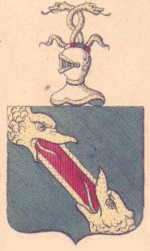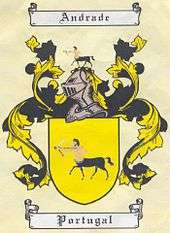Andrade

Andrade is a surname of Galician origin, which emerged in the 12th century as the family name of the knights and lords[1][2] of the small fiefdom of San Martiño de Andrade (St. Martin of Andrade) in northern Galicia, Spain, and which developed in the 16th century into the . Pontedeume, Ferrol and Vilalba were given in the 14th century to Fernán Pérez de Andrade by the king Henry II of Castile due to his services against his brother the King Pedro of Castile.
There's a notable Jewish branch which originated in Portugal in the 17th century as da Costa d'Andrade, and soon moved into England.[3] The surname Andrade is found predominantly in Portugal and Spain, and in countries of Latin America, Italy, Equatorial Guinea and East Timor, Goa, Philippines, and Karnataka in India. There is an important concentration of Andrade families residing in the United States, specifically, California, Massachusetts, Hawaii and Rhode Island.
The aristocratic family of Andrade

The Andrade, sometimes spelled Andrada, became a powerful family in north-western Iberian peninsula during the late Middle Ages and the early Renaissance, time during which they held the titles of Counts of Andrade and Vilalba, amongst others, together with numerous castles, palaces, manor houses and extensive lands. The City of Ferrol and the borough of Pontedeume in particular, have always been regarded as the areas with the closest attachment to the Andrades, to the point, that Pontedeume have always been, and still is, known as The Borough of Andrade.
The two Galician Regions of Ferrolterra and Terra Chá (i.e. the Province of Mondoñedo which disappeared as a province in the 1833 territorial division of Spain though still exists as the Roman Catholic district of the Diocese of Mondoñedo-Ferrol) are known to have been part of the domains of Fernán Pérez de Andrade in the 14th century. Fernán Pérez de Andrade was made Count of Andrade and Pontedeume, and Lord of Ferrol, Serantes and Vilar. Later the family would obtain the title of Counts of Vilalba under the Catholic Monarchs gaining full control over the entire Terra Chá Region in today's Lugo Province. Most of the Galician properties, palaces and castles of the Andrade family these days belong to the House of Alba, and the present Countess of Andrade is Cayetana Fitz-James Stuart, 18th Duchess of Alba.
- From one branch of this lineage: Ángel García Valerio, descendant of Ciprian Valerio Piñeiro y Andrade owner of the small fiefdoms of Serantellos and San Juan de Filgueira (second half of the 19th century). Member of the Spanish Parliament from Ferrol between 1918 and 1923.
- From another branch of the same lineage: Francisco Franco, Spanish Dictator 1936-1975, signed his 1942 novel Raza (Race) as Jaime de Andrade, using part of his mother's (Pilar Bahamonde Pardo de Andrade) maternal surname.
- From another branch of this lineage: Marco Tabili de Andrade y Feria, Secretary of the Royal House of Savoy-Aosta

The Portuguese branch

This family soon spread to Portugal. This happened several times and with several different branches of the Andrade. The most important branch to go to Portugal was that of the 14th century Freire de Andrade in the person of Rui Freire de Andrade and his two sons, Nuno Rodrigues Freire de Andrade, later 6th Grand-Master of the Order of Christ, and Vasco Freire.

From this branch of the Freire de Andrade came João Fernandes de Andrade who, having served the Portuguese Kings Afonso V and John II in the conquest of the Moroccon strongholds of Tangier and Asilah, was granted a new Coat of Arms and possessions in the Portuguese Island of Madeira, namely in Arco da Calheta (Bow of the Calheta). João Fernandes de Andrade, known also as João Fernandes de Andrade do Arco, married Beatriz de Abreu and had prolific issue, descendants of whom were present in the colonization of Brazil. Jacob Velosinho de Andrade translated Saul Morteira's "Torat Mosheh" into Portuguese under the title "Epitome de la Verdad de la Ley de Moyses."[4]
People with the surname
- Alberto Andrade, Peruvian politician
- Aloysio de Andrade Faria, Brazilian businessman
- António de Andrade, Portuguese priest, the first European to explore Tibet
- Billy Andrade, American golfer
- Carlos Drummond de Andrade, Brazilian poet
- David Andrade, Australian anarchist
- Demetrius Andrade, American boxer
- Dino Andrade, American voice actor
- Diogo Andrade, Portuguese former footballer
- Edward Andrade, English physicist
- Fernão Pires de Andrade, Portuguese merchant
- Francisco Andrade Marín, former President of Ecuador
- Glauber de Andrade Rocha, Brazilian filmmaker.
- Hernán Andrade, Mexican racewalker
- Hope Andrade, American politician
- Ignacio Andrade Troconis, former President of Venezuela
- Jaime Andrade Jr., Illinois politician
- João Henrique de Andrade Amaral, Brazilian footballer
- Joaquim Pedro de Andrade, Brazilian filmmaker
- Jorge Andrade, Portuguese footballer
- Jorge Luís Andrade da Silva, Brazilian footballer
- José Bonifácio de Andrade e Silva, Brazilian statesman
- José Leandro Andrade, Uruguayan footballer
- José María Reina Andrade, former President of Guatemala
- Lady Andrade (born 1992), Colombian footballer
- Leny Andrade, Brazilian singer
- Librado Andrade, Mexican boxer
- Manuel de Jesús Andrade Suárez, Colombian writer, journalist and politician
- Mário de Andrade, Brazilian poet
- Mário Pinto de Andrade, Angolan politician and writer
- Marta Andrade, Spanish figure skater
- Maxwell Cabelino Andrade, Brazilian footballer
- Mayra Andrade, Cape Verdean singer
- Moisés Matias de Andrade, Brazilian footballer
- Olegario Víctor Andrade, Argentine journalist, poet and politician
- Oswald de Andrade, Brazilian poet
- Andrade Street in Manila, Philippines
See also
- Iberian naming customs
- List of most common surnames
- Alonso Pita da Veiga In the Battle of Pavia under the orders of Count Fernando de Andrade (1525)
- Ferrolterra Connections of the Andrade family with Ferrol (Counts of Andrade). North-western Spain.
- Terra Chá Region Connections of the Andrade family with Villalba (Counts of Villalba). North-western Spain.
References
- ↑ Lamigueiro, José Luis. "Andrade, s. XI-XIV". Xeneaoxías do Ortegal. Retrieved 30 December 2016.
- ↑ Correas Arias, José Francisco (2009). A casa de Andrade, 1160-1540 : nobreza, mentalidade e ideoloxía na Galicia baixomedieval (1a ed.). Noia: Toxosoutos. ISBN 978-84-96673-87-8.
- ↑ http://www.pjohnp.me.uk/famhist/andrade.htm
- ↑ Bibliography: Kayserling, in Hebr. Bibl. 1860, iii. 58, 59;idem, Bibl. Esp.-Port. Jud. pp. 12, 13.D.
External links
- (in English) http://jewishencyclopedia.com/view.jsp?artid=1499&letter=A. Jacob Velosinho de Andrade, wrote a defense of Judaism in six volumes against Isaac Jaquelot under the title "Messias Restaurado Contra el Libro de M. Jaquelot, Intitulado: Dissertaciones Sobre el Messias" (The Restored Messiah, Against M. Jaquelot's Book, Entitled: A Dissertation Concerning the Messiah). It has remained in manuscript.
- (in Portuguese) Andrade RV
- (in English) short biography concerning the Chief Rabbi of Bordeaux; Rabbi Abraham Andrade, in Bordeaux France
- (in Spanish) Book about the Castle of Andrade in Narahío, Ferrolterra
- (in Spanish) Pictures of the Tower of Andrade in the centre of town in "Ponte de Eume" Ferrolterra
- (in English) Pictures of the Castle of Andrade in the outskirts of "Puente de Eume" Ferrolterra
- (in English) Ancestry.com Interesting American Web-site for Surname Researches
- (in Portuguese) Andrade origin in a Portuguese genealogical site
- (in Galician) Andrade origin in a Galician genealogical site
- (in Galician) Tower of the Andrade Counts of Villalba in the Terra Chá Region - Built at the very end of the Middle Ages 14th Century